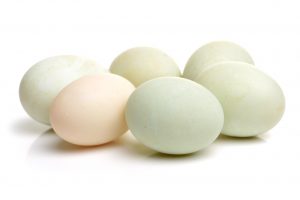written by: jacquie jacob, university of kentucky

introduction
duck eggs are more popular in asia than in north america, but there are many reasons for keeping ducks for egg production in a small flock. ducks typically lay more eggs than chickens. commercial chickens lay about 250 eggs a year, but commercial ducks can lay 300-350 eggs per year. large chicken eggs weigh 24-26 ounces per dozen while duck eggs weigh 32-34 ounces per dozen. duck eggs are also higher in omega-3 fatty acids and stay fresher longer. while ducks consume 20-30% more feed per dozen eggs produced than chickens, they can forage to meet some of their nutritional requirements. ducks lay more than 95-98% of their eggs in the morning by 9 am so eggs can be collected in the morning before the ducks are let out to forage during the day.
nutrition
there is very little published research that addresses the nutritional needs of egg-laying ducks kept in north america. most of the research is based in asia. the ‘duck – beplay官网全站苹果 guide‘ by the central poultry development organization, southern region, produced a table on the nutritional requirements for egg-producing khaki campbells. see table 1. metzer farms, a breeder of commercial egg-laying ducks, have the nutritional requirements listed in table 2.
| nutrient | starter | grower | layer |
|---|---|---|---|
| dry matter, % | 89 | 89 | 89 |
| metabolizable energy, kcal/kg | 2600 | 2500 | 2600 |
| crude protein, % min | 20 | 16 | 18 |
| crude fiber, % max | 7 | 8 | 8 |
| calcium, % min | 1.00 | 1.00 | 3.00 |
| available p, % min | 0.50 | 0.50 | 0.50 |
| linoleic acid, % min | 1.00 | 1.00 | 1.00 |
| lysine, % min | 0.90 | 0.60 | 0.65 |
| methionine, % min | 0.30 | 0.25 | 0.30 |
| total sulfur amino acids, % min | 0.60 | 0.50 | 0.55 |
| salt, % max | 0.60 | 0.60 | 0.60 |
| nutrient | starter 0-2 weeks | grower 3 wees to 1st egg | egg production |
|---|---|---|---|
| metabolizable energy, kcal/kg | 2920 | 3010 | 2740 |
| crude protein, % | 22.0-22.5 | 17.5-19.0 | 17.5 |
| crude fat, % | 4 | 4 | 5 |
| linoleic acid, % | 1 | 1 | 1.5 |
| crude fiber, % | 4 | 5 | 5 |
| calcium, % | 1.00 | 0.90 | 3.00 |
| available phosphorus , % | 0.40 | 0.35 | 0.40 |
| sodium, % | 0.14 | 0.14 | 0.14 |
| chloride, % | 0.16 | 0.16 | 0.16 |
| lysine, % | 1.16 | 0.90 | 0.94 |
| total sulfur amino acid, % | 0.76 | 0.77 | 0.80 |
feeding
ducks can be given their feed as a dry mash, a combination of dry/wet mash, or pellets. they should never be given access to feed without water nearby. it is best to place the waterer directly next to the feeder and make the water available at all times. without water, ducks can choke on their feed.
when ducks are allowed to forage, it is recommended that the ducklings receive feed ad libitum for the first eight weeks. after that they should be fed twice a day – first thing in the morning and then early afternoon.
ducklings will typically consume 12.5 kg (27.6 lb.) up to 20 weeks of age. laying ducks typically consume 120 grams (0.25 lb.) of feed each per day although the amount of feed will vary depending on the level of production and the availability of foraging material.
ducks do not normally need medicated feed since they are resistant to most of the common avian diseases. medicated chicken feed can be toxic to waterfowl. typically this is because the medication is included in the chicken feed at a level that will provide the correct dose to the chickens based on the amount of feed they will eat. since ducks consume more feed than chickens, they will receive too high a dose of the medication.

